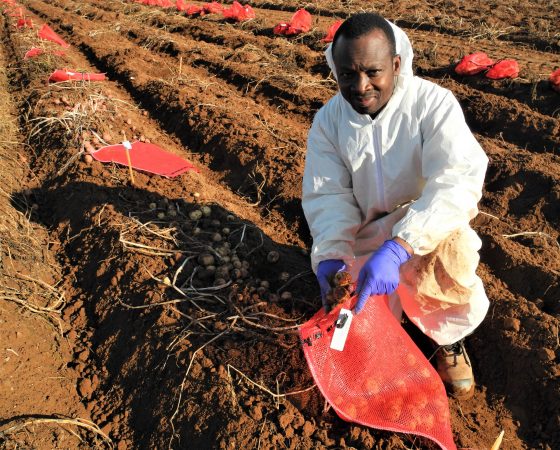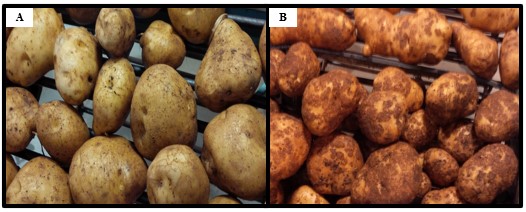
News
Diseases
Research
Developing common scab resistance through genetic research
December 15, 2020 By Agriculture and Agri-Food Canada
No potato producer wants to find deep, rough and pitted lesions on the skin of their potatoes. Common scab is a widespread disease issue that can lead to major economic losses – at least $17 million per year – for producers across Canada. Lost profits from waste occur when more than five per cent of a potato is affected by common scab, which means they cannot be sold to the fresh vegetable market. Also, the lesions make potatoes difficult to peel, resulting in waste and lost profits in the chip and fry markets. Many regions are experiencing warmer and drier growing seasons, which leads to more instances of common scab in potatoes.

Bourlaye Fofana harvesting potato varieties at AAFC Harrington Research Farm. Photo courtesy of AAFC.
Prince Edward Island-based Agriculture and Agri-Food Canada (AAFC) researcher, Bourlaye Fofana, grows 814 different genetic lines of potatoes in fields at AAFC’s Harrington Research Farm, all in pursuit of finding potatoes that are resistant to disease, drought and greening.
Fofana is working to develop potato varieties that are resistant to common scab, making crops more plentiful and profitable, and providing blemish-free produce for consumers around the world through the country’s first-ever Food Policy for Canada, announced in July 2019. Additionally, the Surplus Food Rescue Program is helping to manage and redirect existing potato surpluses to organizations that address food insecurity among Canadians to ensure that these potatoes are not wasted.
At AAFC laboratories in Charlottetown and the Harrington research farm, Fofana recently completed comparative gene expression profiling by studying genes to find statistically significant differences between two potato varieties: a potato variety that regularly develops common scab (Green Mountain) and one that tends to develop fewer common scab symptoms (Hindenburg).
Fofana’s research team identified a set of 273 different genes in 34 biochemical pathways (a series of connected biological reactions that support one another) that likely differentiate Green Mountain and Hindenburg potato varieties and that might be responsible for common scab resistance in some potato varieties.
The data suggests that comparative gene expression profiling can be used to predict common scab lesions in potato breeding varieties. Comparative gene expression profiling is the measurement of the activity (the expression) of thousands of genes at once. These gene activities are then compared between two organisms (potato variety).

Potatoes showing common scab disease reactions. A, the scab-resistant cultivar Hindenburg; and B, the scab-susceptible cultivar Green Mountain. Photo courtesy of AAFC.
“The research revealed that the common scab-resistant variety, Hindenburg, has developed an ability to sense and prepare itself against common scab disease attacks over time as an immune priming mechanism,” Fofana explains.
He is hopeful that, with additional research, this new information could help Canadian potato breeding programs, including the breeders at AAFC’s Fredericton Research and Development Centre in New Brunswick.
“Common scab resistance is a high priority trait within AAFC’s potato breeding program,” says David De Koeyer, AAFC scientist and potato breeder. “The work conducted by Dr. Fofana will introduce more precise screening tools that will help us identify resistance clones earlier in the breeding cycle.”
The identification of the precise genes that affect common scab resistance will have a significant impact on potato breeding and ultimately will provide producers with a way to control this major disease, resulting in less waste and increased profits.
Print this page